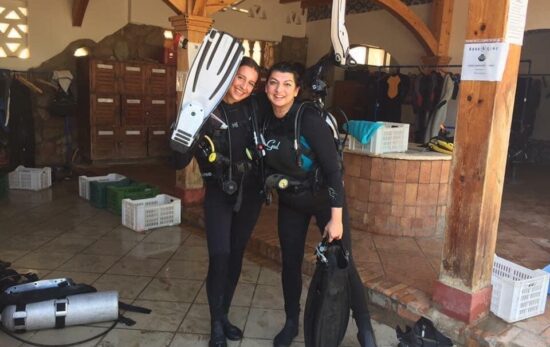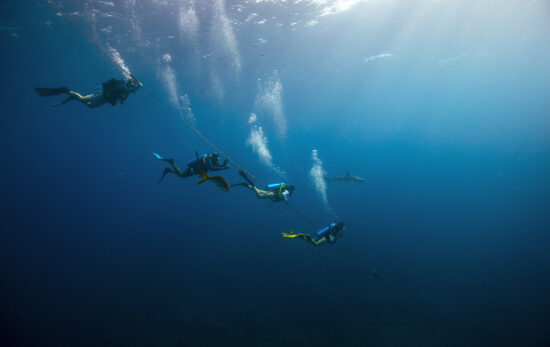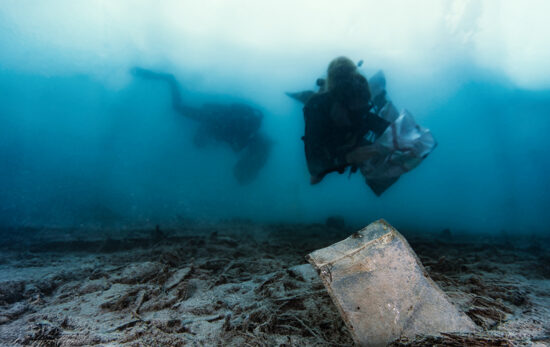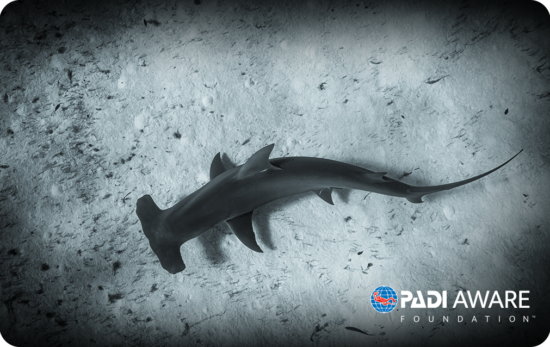With over 500 species of sharks in the oceans of our planet, it’s safe to say there’s a huge variety of animals we can call sharks. Although there may be a typical shark image that comes to mind when thinking of these creatures, there are all types, including sharks with gigantic mouths and others that cut out cookie-like chunks from the bodies of their prey. The variety in size, shape, and even migratory behaviour is immense. And, if you want to save them all, you’re going to need to know how to make all of them sound super cool, so we’ve put together a list of seven epic sharks you should tell your friends about, including the basking shark plus lesser-known species like cookie-cutter sharks.
Some of these sharks are truly unbelievable! While you’re at it, be sure to also check out the best places to dive with sharks.

Basking Shark
- Where to See Basking Sharks: United Kingdom
- Time of Year: April – October
- Maximum Length: 11 meters (36 feet)
Without a better word, the basking shark is humungous, spanning up to 11 meters (36 feet) in length and up to 3.9 metric tonnes (4.3 tons) in weight! These are a migratory species, commonly found in British and Irish waters with tracking to show that they avoid cross-ocean migration. The dark grey/brown-toned basking shark feeds on zooplankton by opening its wide mouth peppered with very small teeth. In a single hour, this shark species can filter up to 6,000 litres (approximately 2,000 gallons) through its lengthy gill slits.
Frilled Shark
- Where to See Frilled Sharks: Unknown, deep sea
- Time of Year: Unknown
- Maximum Length: 2 meters (7 feet)
Although sweetly named, there is nothing sweet about frilled sharks. The name comes form the frilly appearance of their gill slits, which make these sharks look positively prehistoric. Long streamline bodies allow these pelagics to swim quickly, like eels, while grabbing their prey with long rows of teeth. However, this spooky species spends the majority of time in the deep, deep sea, making an encounter very unlikely.

Goblin Shark
- Where to See Goblin Sharks: Atlantic, Pacific and the Indian Ocean
- Time of Year: April – October
- Maximum Length: 3 to 6 meters (9.8 to 20 feet)
The goblin shark is a slightly more spine-chilling species compared to other members of the Chondrichthyes class (meaning cartilaginous fish). A protruding snout rests over 35 to 53 rows of upper teeth and 31 to 62 rows of lower teeth, differing in size depending on their role when eating. Interestingly, they are fairly slow swimmers yet neutrally buoyant, preventing disruption to the surrounding water as they sneak up on prey. This species lurk far below sea level at 890 feet and beyond. Lastly, you’ll be happy to know that the goblin shark has no interest in dining on humans.
Cookie-Cutter Shark
- Where to See Cookie-cutter Sharks: Tropical and Temperate Latitudes, near islands (but not much information is known about this species.)
- Time of Year: Year-round
- Maximum Length: 18 – 20 inches (45.7 to 101.6 cm)
Cookie-cutter sharks can be quickly spotted thanks to the dark markings around their neck like a collar. A freaky physical feature of this species is their green-glowing organs visible on their undersides. Cookie-cutters are classed as parasites in the ocean, as they feed off larger species, leaving cookie-cutter-like chunks missing! As the species is so small and these sharks spend the majority of their time in very deep water, little is known about their location and migration tendencies.

Lemon Shark
- Where to See Lemon Sharks: Atlantic & Pacific Ocean
- Time of Year: Year-round
- Maximum Length: 3 meters (10 feet)
With a lemony hue to their skin, lemon sharks blend perfectly into sandy banks, their camouflage providing a helping hand when tracking prey. A robust shape and short snout are ideal qualities for hunting manta rays, bony fish and crustaceans. Plus, they often hunt in congregated groups, and these groups can also sometimes be spotted resting on sea beds (cleaning stations) together.
Megamouth Shark
- Where to See Megamouth Sharks: Unknown, deep sea
- Time of Year: Unknown
- Maximum Length: 5 meters (16 feet)
A striking mouth gape reaching up to a maximum of 1.3 meters (4 feet) is the megamouth shark’s most prominent feature. As well as the salient appearance, this large mouth is crucial for feeding. It allows them to conveniently feed and filter their food out through gills. Megamouths lurk in deep dark waters, possibly all the way down to 4600 meters (15,000 feet), lugging around their huge bodies – with an extreme maximum weight of 1,215 kilograms (2,700 pounds). Additionally, this species is seriously rare, and only 60 have ever been found by researchers.

Bonnethead Shark
- Where to See Bonnethead Sharks: Western Atlantic (Rhode Island to Gulf of Mexico), Caribbean (Bahamas and Cuba), Eastern Pacific
- Time of Year: Year-round (preferably in the warmer seasons in each location)
- Maximum Length: 1.5 meters (5 feet)
Bonnethead sharks are one of the hammerhead species, with smooth, circular, bonnet-like snouts (most hammerheads tend to have ridges in their snouts). The bonnethead shark is a migratory, and these sharks are social beings, often migrating in groups to warmer climates in the winter and cooler waters in the summer. With average habitat depths of 10 to 25 meters (31 to 82 feet), bonnetheads are a more common encounter in subtropical waters compared with other shark species. Due to overfishing, bonnethead sharks are unfortunately classed as an endangered species. Learn more about how you can support endangered species by diving here.
Ready to Meet Some Sharks?
While it’s unlikely your next scuba diving vacation will involve hanging out with cookie-cutter sharks or megamouths in the unknown deep waters, you could definitely plan a trip to encounter others. Take a trip to Fiji or a liveaboard in the Solomon Islands to search for lemon sharks. Or, head to PADI Adventures and book a day trip in search of basking sharks in the United Kingdom.
PADI Travel’s Scuba Travel Experts are available 24/7 to help you decide on your next shark adventure to tell your friends all about!





